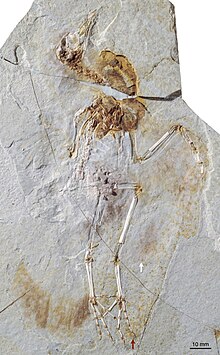Hongshanornis longicresta
|
Hongshanornis Temporal range: Early Cretaceous, 124.6–122 Ma |
|
|---|---|
 |
|
| Fossil specimen | |
| Scientific classification | |
| Kingdom: | Animalia |
| Phylum: | Chordata |
| Clade: | Ornithuromorpha |
| Family: | †Hongshanornithidae |
| Genus: |
†Hongshanornis Zhou & Zhang, 2005 |
| Species: | †H. longicresta |
| Binomial name | |
|
Hongshanornis longicresta Zhou & Zhang, 2005 |
|
Hongshanornis is a genus of ornithuromorph birds known from early Cretaceous lake deposits of the Yixian Formation, Inner Mongolia, China. The holotype specimen, recovered in 2005, is currently held by the Institute of Vertebrate Paleontology and Paleoanthropology in Beijing. It was found in the Jianshangou fossil beds, dated to 124.6 million years ago. Three additional specimens have been reported, though only one of those has been definitively identified as belonging to Hongshanornis. This latter specimen was found in the Dawangzhangzi fossil beds, which are about 122 million years old.
Hongshanornis is a member of the group Hongshanornithidae, to which it lent its name. It is closely related to Longicrusavis, which existed alongside Hongshanornis in the Dawangzhangzi ecosystem, and is very similar to the later Parahongshanornis from the Jiufotang Formation.
Hongshanornis longicresta was a small species, especially compared to other early ornithuromorphs (birds with a modern tail anatomy), about the size of a thrush, and adult specimens are estimated to have weighed about 50 grams (1.8 oz) in life, with a wingspan of about 0.32 metres (1.0 ft).
The skull in all known specimens is poorly preserved, but in general appears to have had a narrow snout compared to the closely related Longicrusavis. The teeth were very small and are poorly preserved in all known specimens. At first, this led scientists to conclude that the teeth were absent in both the upper and lower jaws, probably replaced with a beak. However, later study of the type specimen showed that tooth sockets were present in the preserved parts of the jaw, and comparison with related forms showed that it did have teeth. The discovery of a more well preserved specimen confirmed the presence of teeth in at least the maxilla (middle of the upper jaw) and dentary (lower jaw). The snout appears to have lacked feathers, though whether it was only covered in skin or some parts bore a beak is currently unknown. The describers of Hongshanornis noted a unique bone in the end of the lower jaw which they equated with the beak-bearing "predentary bone" similar to the one found in ornithischian dinosaurs. Such bones have also been found in more advanced birds like Hesperornis. However, other scientists have pointed out that the "predentary" (or, technically, mandibular symphysial ossification) of Hongshanornis lacks the characteristic pits and grooves associated with the beak in early beaked birds like Archaeorhynchus, and that the presence or absence of any beak is unclear.
...
Wikipedia
